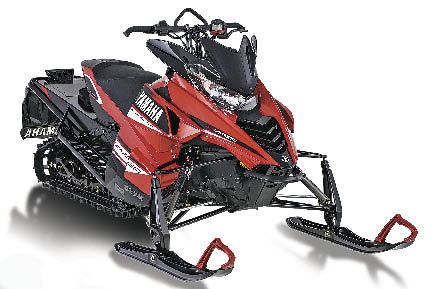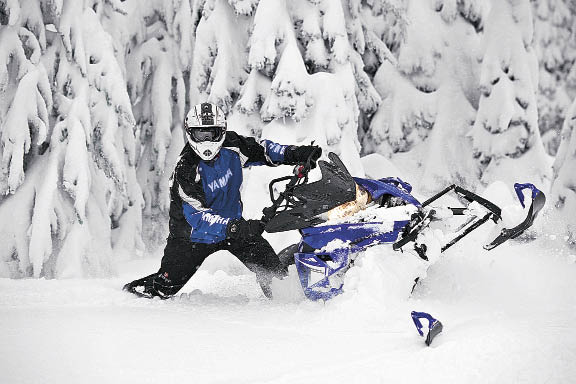 In last season’s March issue of SnoWest Magazine, we wrote, “Yamaha caught pretty much everyone by surprise when the Japanese company unveiled one of its newest snowmobiles for model year 2013.
In last season’s March issue of SnoWest Magazine, we wrote, “Yamaha caught pretty much everyone by surprise when the Japanese company unveiled one of its newest snowmobiles for model year 2013.
“Nobody expected this.”
Then we told you about the new SRX 120 sled, aimed at the youngest of sledders. The SRX 120 is built by Arctic Cat with a Yamaha engine.
Now fast forward to model year 2014 and we say, “Wow, Yamaha really pulled a surprise for next season.”
What started out small--quite literally with the SRX 120--has morphed into something really big, bigger actually than just the five new SR Viper sleds that Yamaha unveiled. Bigger as in that the sleds are being built in North America by Arctic Cat using an Arctic Cat chassis with Yamaha’s Nytro engine (Genesis 3-cylinder liquid-cooled 1049cc). How about that?
Rumblings
There were rumblings over the past few months such a move was going to take place but nobody really knew for sure what was going down until Yamaha unveiled its SR Viper lineup to the media in mid-January.
Just to be crystal clear, the SR Viper is a Yamaha snowmobile that will be sold at Yamaha dealerships.
That makes us think perhaps the most interesting meeting that took place this winter was the Yamaha dealer meeting in Minneapolis, MN, in February. By the time you read this the meeting will be over and we’ll have taken a test ride on the new Yamahas.
So is Yamaha crazy like a fox or just crazy? Certainly time will tell.
With that kind of news, there won’t be much talk about Yamaha’s mountain sleds, which return relatively unchanged for 2014. In fact, the only change to the FX Nytro MTX 153 and 162 is that both sleds get the powder skis as well as a new color scheme. The Phazer MTX comes to 2014 with no changes.
Yamaha is offering a crossover sled—the SR Viper XTX SE—in the Arctic Cat chassis. That instantly makes the Yamaha crossover more competitive as it has a mountain strap and will be lighter and more nimble. More on that in a bit.
How About Us?
 Doesn’t all this beg the question, “What’s next for Yamaha’s mountain lineup?” We asked that very question during the sneak peek and were told to be patient. That at least indicates that something may be in the works. Whether that’s next season or not, we’re not sure. We’ll stay on it though, and give updates as we find out any additional information.
Doesn’t all this beg the question, “What’s next for Yamaha’s mountain lineup?” We asked that very question during the sneak peek and were told to be patient. That at least indicates that something may be in the works. Whether that’s next season or not, we’re not sure. We’ll stay on it though, and give updates as we find out any additional information.
What we do know is that the Yamaha-Arctic Cat accord is a “mutual supply agreement,” according to Yamaha officials. As we told you in the Arctic Cat story in this issue, Cat is using the Nytro (Genesis 3-cylinder liquid-cooled 1049cc engine but “renamed” by Cat the 7000 Series C-Tec4 1049) in a small number of its sleds.
“We needed to look forward,” Peter Smallman-Tew, Yamaha Motor Canada vice president and North American snowmobile leader, said in January of the agreement between Yamaha and Cat. “Today you’ll see just the tip of the iceberg.”
Then, sensing there might be some question as to the future of Yamaha snowmobiles, Smallman-Tew said, “We are more committed today than we have ever been.”
Rob Powers, Yamaha snowmobile product manager, also commented, “Arctic Cat has their plan and we have our plan.”
Later during Yamaha’s 2014 lineup unveiling, Smallman-Tew said, “We want to reinvent ourselves. For us to survive we had to think outside the box. We’re challenging the normal.” Then, backing up what Powers said earlier in the morning, Smallman-Tew said, “We have our business strategy, they (Arctic Cat) have their business strategy. We are still competitors.”
Includes Yamaha DNA
In an effort to refocus the media on Yamaha’s side of the “mutual supply agreement,” Chris Reid, Yamaha’s snowmobile product planning manager, said, referring to the SR Viper, “There’s still DNA in this snowmobile that’s Yamaha.”
Another question, among many, that arose during Yamaha’s media intro was whether consumers would see a two-stroke Yamaha again. To that, Reid said, “We still are committed to 4-stroke engines.”
In talking more in-depth about the SR Viper models, Yamaha officials pointed out that in addition to using the Yamaha Genesis powerplant (with electric start and EBRS system-reducing compression braking), Yamaha clutches will be stock on this sled although Yamaha and Arctic Cat are working together on the clutching, gearing and mapping. One noticeable change riders will appreciate is the electronic reverse system on the new Yamaha, offering servo-controlled, push button actuated shifting. No more manually trying to get the sled in reverse with a handle that was somewhat temperamental at times—at least on the SR Viper sleds.
The rear suspension, which again is a Cat suspension, will be calibrated the same as what you would find on a similar Cat version of the sled. The SR Viper will also use Arctic Cat skis “at least for the first year.”
Here’s an interesting twist, pun intended: On the SR Viper there is no rear-exiting exhaust, which had become a trademark element of Yamaha and its four-stroke engines. Instead, the SR Viper will have a bent pipe, with the exhaust exiting out on the side of the machine where traditional two-stroke engines’ exhaust exits.
The SR Viper will also be using a Hayes Brake system, which is what you find on Cat sleds, too. Other features Yamaha riders will get with the Cat chassis is the seat, bigger gas tank (10.6 gallons vs. 7.3 gallons on the Nytro), adjustable ski stance, open running boards so snow won’t build up (definitely an issue on the Yamaha running boards), more ergonomic steering and easy-to-use hand/thumb warmers and reverse button. The sled also features new gauges with mph, temp, altimeter, hours, fuel, intake air temp, voltage meter, oil pressure, rpm, clock and trip meter readings.
Crossover SR Viper
 The crossover SR Viper XTX SE includes most all the features of the trail version SR Viper with some additional features like a performance-tuned dual shock SR 141 rear suspension and a 15x141x2.6-inch Cobra track. On the front there are Fox Float 2 shocks and plastic mountain skis. The tall riser bar comes with a mountain strap for sidehilling ease.
The crossover SR Viper XTX SE includes most all the features of the trail version SR Viper with some additional features like a performance-tuned dual shock SR 141 rear suspension and a 15x141x2.6-inch Cobra track. On the front there are Fox Float 2 shocks and plastic mountain skis. The tall riser bar comes with a mountain strap for sidehilling ease.
Yamaha is also heading into the 2014 winter season with a Phazer XTX, a crossover model with a 14x144x1.5-inch Freeride track. The engine is the same as what you’ll find in the Phazer MTX.
We think all this—from the “mutual supply agreement” to the actual new Yamaha snowmobiles—might take a while for sledders to digest. So while you’re mulling all that over, we also learned that Yamaha is moving its chassis engineering to Minoqua, WI, from Japan. Honestly, that’s a great move and probably long overdue. The sleds are “on the ground” so to speak in Wisconsin and the feedback and turnaround on development will be much quicker, allowing Yamaha to more quickly develop new product.
Our fingers are crossed that the new product includes something for the mountains.